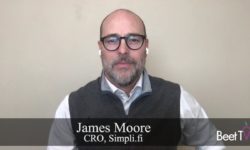FORT WORTH – Connected TV has the ability to target TV ads at the household level – but, because households in a given area are often similar, often what that means is that ad buyers target local areas by proxy.
That is reigniting the practice of local ad sales, even for national brands that, previously, were not big buyers of local cable.
According to Frost Prioleau, CEO of programmatic demand-side platform Simpli.fi, what’s old is new again.
Local for national
“When we started in local, it was a DMA (designated media area),” he says in this video interview with Beet.TV.
“And then it went to a city (level), and then it went to a zip code. And what we launched a couple of years ago was household addressable, household-level local.
“If you start targeting and allowing advertisers to say, ‘Hey, I just want to target the households that have a household income of this or have two kids under two or voted this way in the last election’, all of a sudden that becomes very interesting to national advertisers who are looking to target their audiences nationally.
“It’s gotten so local that now we’re national again, and running campaigns. Last month, we ran 120,000 live campaigns for, like, 30,000 different advertisers. And that’s really across the spectrum from million-dollar-a-month CTV campaigns to a few hundred dollars a month local campaigns.”
DSP shake-out
Simpli.fi’s platform, operating since 2015, allows marketers to create, optimise, expand and understand audiences.
Prioleau says recent consolidation within Simpli.fi’s DSP segment has changed the picture.
“Many of them have been bought closed, acquired, etcetera,” he says. “There are really not that many independent DSPs out there.
“A DSP is not an ad network that that takes and arbitrages media, but a DSP in our view is one that shows full transparency. So on every impression, the advertiser can understand how much of his budget went to media, how much went to data, and how much went to the DSP and or service charges.”
Post-pandemic bounce
Despite a terrible year with the pandemic, connected TV has been a ray of light.
And Prioleau sees ad spend returning into 2021.
“In Q3, our CTV revenue was up 145%,” he says. “It’s actually trending higher than that after Q3 in October. So that continues to accelerate and become a significant part of our business.
“One of the segments that we’ve seen hurt the most are the smallest advertisers in 2020, as they shut down advertising in the pandemic.
“We’re seeing them come back now. So we’ll expect the smallest advertisers to grow more quickly next year, certainly than they did in 2020.”
You are watching “Streaming Boom Accelerates the Adoption of CTV,” a Beet.TV leadership series presented by Simpli.fi. Please visit this page for more videos.

































